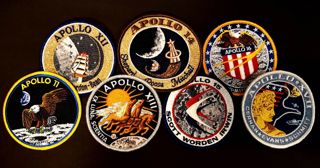
Apollo Mission Patches
- 16th Jan 2019
- Author: Hannah Baker
Artistic ability probably isn’t the first thing you’d think of when listing the skills needed to become an astronaut. But an eye for design certainly comes in handy for one of the first jobs astronauts have to do when assigned to a mission: design their own mission patch.
This might seem like a trivial diversion, but when you consider that whatever the astronauts come up with will go down in history as the symbol of their mission, the pressure is on to get it right. The patches from the Moon landings are some of the most iconic in spaceflight history. Here are some of the stories behind their designs…
Apollo 11
Michael Collins designed the Apollo 11 mission patch with the help of his crewmates Neil Armstrong and Buzz Aldrin. Breaking with tradition, they chose not to include their names to show they represented everyone who worked towards the historic mission.
Collins used National Geographic magazines to find the perfect eagle for the design – with its legs outstretched, coming in to land. It holds an olive branch to symbolise a peaceful landing by the United States.
In the original design, the eagle held the olive branch in its beak, with its talons extended. NASA officials rejected this design because they felt the eagle looked too aggressive!
Apollo 12
The Apollo 12 crew designed their patch with the help of their NASA colleagues. All three crew members were United States Navy Commanders, so they chose traditional Navy colours – gold and blue.
The crew asked artist Victor Craft to draw the final design of a clipper ship flying the U.S flag to the Moon.
The three stars above the ship represent each crew member, with a fourth star to represent Clifton Williams, who would have flown on Apollo 12 had he not been tragically killed in a plane crash.
Apollo 13
Apollo 13 Commander Jim Lovell began designing a patch with the idea of the Greek god Apollo driving his chariot across the sky, dragging the Sun with it.
He gave the idea to artist Lumen Winter, who came up with the three-horse design symbolising Apollo riding across the sky towards the Moon.
Lovell included the Latin words, Ex Luna Scientia – meaning “From the Moon, knowledge” to emphasise science was an important part of Apollo 13. This phrase is a parody of the U.S Naval Academy’s motto, Ex trident, Scientia – “From the sea, knowledge.”
Apollo 14
In the Apollo 14 patch, the object heading from Earth to the Moon is an astronaut pin. Astronauts were given a silver version of this pin when they were accepted into the astronaut corps and a gold one after their first space flight.
As a joke, the backup crew for Apollo 14 also designed their own patch. A friendly rivalry between the two crews resulted in the prime crew being nicknamed the ‘Three Rookies’ due to their lack of flight time.
The backup crew’s patch had a grey-bearded Wile. E. Coyote (a reference to Shepard’s advanced age) being beaten to the Moon by Roadrunner (the backup crew).
Apollo 15
After evaluating hundreds of ideas for their mission patch, the crew of Apollo 15 asked the Italian designer Emilio Pucci for help. Pucci had been a pilot in the Italian Air Force, so the crew felt his understanding of aviation would transfer to the design.
Pucci’s design included three stylised birds, flying in close formation to represent the three crewmembers working towards their common goal. Two birds fly close to the Moon with the third above – just like the mission itself, where two crewmembers descended to the Moon while the third remained in lunar orbit.
The lunar surface in the background is the actual landing site and includes ‘15’ in Roman numerals amongst the craters.
Apollo 16
The Apollo 16 crew wanted to include the themes of patriotism and teamwork in their patch, along with the mission number and the names of the crew. NASA graphic artist, Barbara Matelski, took their ideas and designed a patch which had everything they wanted.
To show patriotism, an eagle perches on a red, white, and blue American shield.
The yellow chevron symbol, taken from the NASA logo, represents teamwork. There are sixteen white stars around the edge for Apollo 16, along with the names of the crew.
Apollo 17
Apollo 17 Commander Eugene Cernan commissioned artist Robert McCall to design the patch for the last Moon landing. The crew wanted the patch to convey the themes of mankind, country, and future.
McCall based his image of Apollo on the Apollo Belvedere sculpture – one of the most well-known classical representations of the Greek god. He changed Apollo from white marble to gold, to represent the ‘golden age’ of spaceflight.
A simple eagle with red stripes symbolises the United States and three white stars represent the crew. The eagle’s wing overlaps the Moon to show that it has been visited, while Apollo and the eagle look towards the future of human space exploration.
Apollo 50
For the 50th anniversary of the first Moon landing in 2019, the National Space Centre has designed its very own Apollo 50 mission patch.
During the Apollo anniversaries in 2019, we’ll be running mission patch badge making crafts as part of our holiday programmes.
You can also visit our Shop to pick up pin badges, travel mugs, tote bags, and custom Apollo postcards made in-house by our talented space designers.
About the author: Hannah Baker is the Assistant Curator at the National Space Centre.









